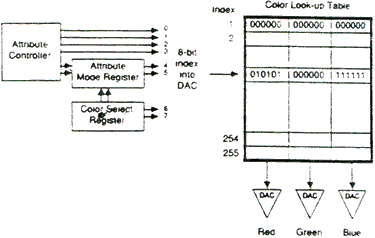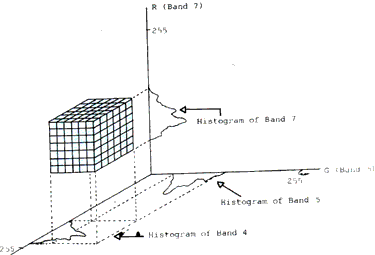| GISdevelopment.net ---> AARS ---> ACRS 1991 ---> Poster Session 2 |
False Color Composite Display
of Mulitband Images on Personal Computer using Cubic Color Block
Technique
Jitkasame Ngarmnil, Sujate
Jantarung
Faculty of Engineering, Mahanakorn College
Nongjok, Bangkok 10530, Thailand
Fusak Cheevasuvit, Kobchiai Dejhan
Faculty of Engineering
King Mongkut's Institute of Technology Ladkrabang
Bangkok 10520, Thailand
Faculty of Engineering, Mahanakorn College
Nongjok, Bangkok 10530, Thailand
Fusak Cheevasuvit, Kobchiai Dejhan
Faculty of Engineering
King Mongkut's Institute of Technology Ladkrabang
Bangkok 10520, Thailand
Abstract
A display technique for false color composite multiband images via the video graphic array (VGA) on personal computer is presented. Since the reflectance's in all band of satellite images are considered as equally importance information. Therefore, to avoid the emphasis of any band image, the cubic color block technique is applied to obtain the almost equally colors shades of three band images. The ratio of three color shades I 7:6:6 for 252 distinct color which is not exceeded the 256 color register index of VGS system. The result shows a colorful image which is not too much different when compared with the expensive computer system.
Introduction
The progress of VLSI makes the personal computer more powerful and cheaper, therefore more and more researchers in Remote Sensing field try to use it for processing and displaying the result in the form of color image. The most to popular of color graphic system for personal computer is vide graphic array (VGA). This graphic system has three color registers for red, green and blue. The capacity of each color register is 6 bits which can provide for 64 distinct color shades. Therefore, the VGS system has 218 distinct colors 218 distinct colors, because of its limitation of the capacity of color index register which is 8 bits. Therefore, it can simultaneously display 256 distinct colors. The problem is arised that who to select the 256 proper colors for displaying the false color composite image. in general, many researchers solved this problem by dividing the 8 bits of color index register as 3:3:2 bits (or 8:8:4 colors) for color register of red, green and blue, respectively. By this combination, there is an emphasis on the first two images, and the third image is considered as least important information. This will be contradicted tot eh concept of displaying information. This will be contradicted to the concept of displaying false color image. since the false color image is composed from multiband images and it is used for interpretation of mulitspectral classification. As we know that each pixel in a satellite image is recorded at many different wavelengths bands. A pixel may be characterized by it spectral signature, which is determined by the multispectral classification is an information extraction process that analysis the spectral signatures and then assign pixels to multi band images are considered as equally important information's for image classification. By this reason this paper presents a cubic color blocks technique for dividing the 8 bits of color register index as an almost equally color shades for each color as mentioned in the next section.
Cubic Color Block Technique
The color look-up table of VGA system, as shown in Fig. 1., consist of three 6 bits color registers which are red, green and blue. These three color registers give combination of 64x64x64 distinct color shades. However, the color look-up table is controlled by 8 bits of color index register. Therefore, the RGB monitor can be simultaneously display 256 color shades ins stead of 64x64x64 color shades. As mentioned, all pixels in multiband images have been considered as equally important information for multi spectral classification. We , then, try to divide these 256 actual color shades for three band images for almost equally number of color shades. For each color, the number of color shades is obtained by cube root of 256 which is about 6.35. That means the three color ratio of red, green and blue is 6;6:6 color shades. However, we can increase one more color shade for any band, then the color ratio will be 7:6:6. This ratio gives 252 color shades which still not excess the 256 color index.

Fig. 1 Color look-up table with 256 color index
A step of each color shade is obtained by dividing the 64 color shades of each color by 6 for red color, by 5 for green and blue color. Then the cubic color blocks are obtained as shown in fig. 2. Each cubic color block corresponds to a color shade which defines by color index in the color look up table. The color ideas in expressed in the following equations.
Color index = (36 x R) + (6 x G) + B

Fig. 2 Cubic colour blocks of three images for displaying false colour composite image
To display a false color composite image, we have to assign the image band 7, band 5 and band 4 to the color axis of red, green and blue, respectively. However, to obtain a colorful image, the dynamic range of each histogram must be considered before assigning a color shade.
Example of false color composite image
The multispectral images of Landsat TM4, TM2, and TM1 over the Loch Raven Reservoir is used for displaying as a false color composite image. By assigning the TM4, TM2 and TM1 to the color red, green and blue, respectively. The false color composite images are shown in the Fig. 3. where the Fig. 3(a) is obtained from the color ratio 8:8:4 and the fig. 3(b) si for the ratio 7:6:6.
Fig. 3 False colour composite image
(a) using the color ratio 8:8:4
(a) using the color ratio 7:6:6
Conclusion
The technique of displaying false color composite image by cubic color block technique is presented. The obtained result is shown in Fig. 3. The comparison of these two images shows obviously that the false color of ratio 7:6:6 give more detail in the urban are a than the false color of ratio 8:8:4. moreover this technique is implemented on a micro-computer with the VGA system, the obtained result is not too different from the result which obtain from the more expensive computer. Therefore, it is very useful for poor or undevelopment country to accomplish the researches in the Remote Sensing field, because of these equipments can be bought by a small budget.
References
- J.A. Richards, Remote Sensing Digital Image Analysis : An Introduction", Springer - Verlag, Berlin, 1986.
- R.A Schowengert, "Techniques for image processing and classification in Remote Sensing, Academic Press Inc. (Harcourt Brace Jovanovich Publishers), Orlando, 1983.
- A.A. Khamis, I.A El-Kassas and E. Jaworski, "Computer-Assisted Classifications of Landsat -TM imagery Data for Geological Investigation of Northeast Qatar Peninsula: The Arabian Gulf", Proceeding of the Twenty-third International Symposium on Remote Sensing of Environment, Bangkok, Thailand, pp. 1029-1040, 18-25 April 1990.